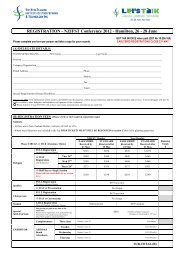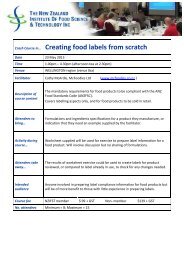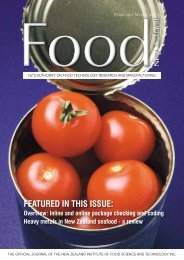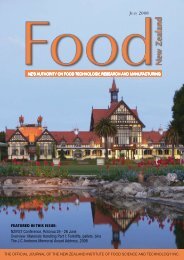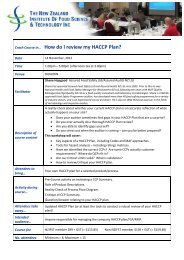UNDERGRADUATE WRIT<strong>IN</strong>GInnovating for increased satiety –developments in the potential role <strong>of</strong>hydrocolloidsDanielle Clapperton, Student, University <strong>of</strong> OtagoThis article was awarded third prize in the <strong>NZIFST</strong> Undergraduate Writing Competition 2011. <strong>The</strong> annual competition is open toundergraduate food science and food technology students who are invited to write on any technical subject or latest development in thefood science and technology field that may be important to the consumer.IntroductionConsumer expectations <strong>of</strong> food products are changing from just therequirement to act as a good source <strong>of</strong> nutrition with acceptable sensoryappeal, to foods that also contribute to health and well-being. Thisacquired role <strong>of</strong> helping to combat major health based issues suchas obesity, cardiovascular disease and Type II diabetes is now forcingthe food industry to investigate new and innovative ways <strong>of</strong> producingfoods with improved functionalities, such as increased satiety 4 .Market research has shown satiety, or fullness, can be considered tobe the next big thing in weight management. If a food product has theability to provide satiety, it will enable consumers to feel content andmake them more likely to succeed in weight loss 6 . With over 1.5 billionadults who are obese worldwide in 2008 (World Health Organisation2011) it can be seen there is real market potential for satiety-inducingfoods and beverages.<strong>The</strong> texture and microstructure <strong>of</strong> food has been shown to have a significantinfluence on the sensation <strong>of</strong> satiety, and it is believed that aslower breakdown <strong>of</strong> a food in the gastrointestinal (GI) tract can leadto a higher sensation <strong>of</strong> satiety 5 .<strong>The</strong> role <strong>of</strong> hydrocolloids in this has been researched for over 30 years 6however recent developments in techniques to study their effect onsatiety and digestion and increased knowledge and research hasopened possible new pathways for product development.What are hydrocolloids?<strong>The</strong> term hydrocolloid encompasses a great number <strong>of</strong> polysaccharidesderived from plant, seaweed and microbial sources. It alsoextends to gums extracted from plant exudates, and modified biopolymersformed from the chemical or enzymatic treatment <strong>of</strong> starch orcellulose. <strong>The</strong>se food hydrocolloids are high molecular weight, hydrophilicbiopolymers. Hydrocolloids are already employed to controlthe microstructure, texture, flavour and shelf-life <strong>of</strong> food products, asfunctional ingredients, while still allowing the production <strong>of</strong> acceptableproducts³.How do hydrocolloids work toincrease satiety?In the human digestive system, the main function <strong>of</strong> the GI tract is toabsorb nutrients, through mechanical and chemical (enzymatic) breakdown <strong>of</strong> ingested food¹. This digestive breakdown is regulated by anumber <strong>of</strong> feedback mechanisms, including hormonal signals suchas ghrelin, a peptide hormone that informs the brain it is time to eatagain, cholecystokinin (CCK), a plasma peptide which regulates gastricemptying and also by physical signals such as stretch receptors. Whena dense hydrocolloid is consumed, ghrelin and CCK are released atmuch greater levels, and gastric stretch mechanisms are activated fora longer period than when a meal high in glucose or fat is consumed.<strong>The</strong> ability to prolong these mechanisms without an increase in energyconsumption has been the concept behind years <strong>of</strong> hydrocolloid andsatiety research 6 .’Gel Raft’ theory<strong>The</strong> formation <strong>of</strong> a theory <strong>of</strong> ‘gel rafts’ that float atop the stomachchyme and which interfere with feedback mechanisms, thus informingthe brain <strong>of</strong> an extended feeling <strong>of</strong> fullness, have been recentlyinvestigated. This research was completed with the use <strong>of</strong> alginates,charged hydrocolloids that contribute to the structural form <strong>of</strong> brownalgae (seaweed). Alginate has the ability to gel in the presence <strong>of</strong> multivalentcations (ionic gelation) and also when the pH <strong>of</strong> a system isbelow 3.5 (acid gelation). During the digestive process, alginate raftsare formed by the action <strong>of</strong> gastric acid upon the soluble alginate t<strong>of</strong>orm an insoluble gel. This is the result <strong>of</strong> the alginate matrix hydratingon contact with gastric fluid leading to swelling <strong>of</strong> the polymer to forma viscous ‘gel layer’².Alginate preparations have now also been shown to modulate appetiteand energy intake via these alginate gels with the ability to slow gastricemptying, stimulate gastric stretch and reduce intestinal nutrientabsorption. Clinical studies into the effect on fullness and hunger, postalginate consumption, using a 1.5g pre-load <strong>of</strong> alginate in the form <strong>of</strong>40Food <strong>New</strong> <strong>Zealand</strong>
UNDERGRADUATE WRIT<strong>IN</strong>GMRI techniques 5 which investigated food behaviour in the stomach.This technique enabled visualisation <strong>of</strong> a gel meal (alginate) to determinefactors such as gastric volumes, and emptying rates. <strong>The</strong>y alsoconfirmed the observation that ingesting gel forming liquids does prolonga person’s satiety.Possible applications andhurdlesWith appropriate alginate formulation, functionally enhanced breakfastbars, milk drinks and other beverages could be the future <strong>of</strong> weightloss management, and are an important area for future food productdevelopment². Alginate, however, is not the only charged hydrocolloidand others such as low methoxy pectin, carrageenan and gellan gumsalso have a future potential as an application, given more research.<strong>The</strong> future trend <strong>of</strong> formulating products that provide satiety or hungersuppression must be balanced with detrimental effects, as the levels <strong>of</strong>hydrocolloids required to induce satiety and functional effects such as‘gel-rafts’ are much greater than required for the stabilisation <strong>of</strong> foodproducts. As a result <strong>of</strong> this, mouthfeel and sensory consequencesmust be taken into consideration 6 .a developed satiety beverage, showed consumption <strong>of</strong> the beveragedid not reduce the amount <strong>of</strong> food consumed, but it did significantlyreduce the onset <strong>of</strong> hunger post the meal and reduced the desire theconsume food between meals. A daily dose over seven days showedthe satiety beverage had a significant effect on the daily energy intake,with a 7% or 135 kcal reduction in energy intake, which is a clinicallysignificant decrease².This research is further backed with in-vivo studies using non-invasiveConclusion<strong>The</strong> ability to formulate foods with improved functionality, such as theinduction <strong>of</strong> satiety though the inhibition <strong>of</strong> gastric transit time andstretch, has great potential in terms <strong>of</strong> the development <strong>of</strong> functionalfoods. Recent theories such as with the formulation <strong>of</strong> ‘gel-rafts’ duringdigestion, show the potential to be helpful in controlling satiety andhelping to curb the escalation <strong>of</strong> obesity and other diet-related issues.This application however, requires the maintenance <strong>of</strong> the eating experiencethat consumers already expect, which could be a hindrance inthe instigation <strong>of</strong> such research and knowledge onto the commercialscale, despite the market appeal.References1. Brownlee IA. 2011. <strong>The</strong> physiological roles <strong>of</strong> dietary fibre. FoodHydrocolloids 25(2):238-250.2. Dettmar PW, Strugala V & Craig Richardson J. 2011. <strong>The</strong> key rolealginates play in health. Food Hydrocolloids 25(2):263-266.3. Dickinson E. 2003. Hydrocolloids at interfaces and the influence onthe properties <strong>of</strong> dispersed systems. Food Hydrocolloids 17(1):25-39.4. Hoad C, Rayment P, Risse V, Cox E, Ciampi E, Pregent S, MarcianiL, Butler M, Spiller R & Gowland P. 2011. Encapsulation <strong>of</strong> lipid byalginate beads reduces bio-accessibility: An in vivo C-13 breath testand MRI study. Food Hydrocolloids 25(5):1190-1200.5. Norton IT, Frith WJ & Ablett S. 2006. Fluid gels, mixed fluid gels andsatiety. Food Hydrocolloids 20(2-3):229-239.6. Paeschke TM & Aimutis WR. 2011. Formulating for Satiety withHydrocolloids. Food Technology 65(3):24-+.7. World Health Organisation. 2011. Obesity and overweight.Accessed: April 11, 2011 from http://www.who.int/mediacentre/factsheets/fs311/en/December 2011/January 2012 41



